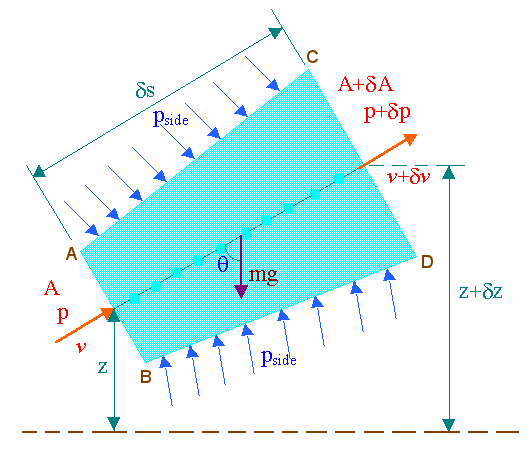

Mass in per unit time = rAv =
![]()
For steady flow, mass out per unit time = ![]()
Rate of momentum in = ![]()
Rate of momentum out = ![]()
Rate of increase of momentum from AB to CD = ![]() = rAv dv à
1
= rAv dv à
1
Force due to p in the direction of motion = pA
Force due to p + dp opposing the direction of motion = (p + dp)(A + dA)
Force due to pside producing a component in the direction of motion = psidedA
Force due to mg producing a component opposing the direction of motion = mgcos(q)
Resultant force in the direction of motion = pA - (p + dp)(A + dA) + psidedA - mgcos(q) à 2
The value of pside will vary from p at AB to p + dp at CD, and can be taken as p + kdp where k is fraction.
Mass of fluid element ABCD = m = rg(A + 1/2 dA) ds
And ds = dz/cos(q); since cos(q) = dz/ds
Substituting in equn.2,
Resultant force in the direction of motion = pA - (p + dp)(A + dA) + p + kdp - rg(A + 1/2 dA) dz
= -Adp - dpdA + kdpdA - rgAdz - 1/2 dAdz
Neglecting products of small quantities,
Resultant force in the direction of motion = -Adp - rgAdz à 3
Applying Newton's second law, (i.e., equating equns.1 & 3)
r
Av dv = -Adp - rgAdzdividing by rAds,


or, in the limit as ds à 0,

This is known as Euler's equation, giving, in differential form

the relationship between p, v, r and elevation z, along a streamline for steady flow.
It can not be integrated until the relationship density and pressure is known.
For incompressible fluid, r is constant; therefore the Euler's equation is integrated to give the following:

which is nothing but the Bernoulli equation.
Last Modified on: 14-Sep-2014
Chemical Engineering Learning Resources - msubbu
e-mail: msubbu.in[AT]gmail.com
Web: http://www.msubbu.in